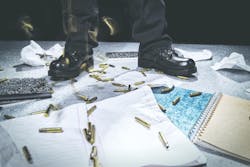Recognize Reality In Active Shooter Scenarios
In March of 1999, you can almost be assured that no school administrator in Littleton, Colo., had thought, “Next month we’re going to have one of the worst school shootings in history happen right here at Columbine.” In March of 2008 at Virginia Tech, it was probably the same scenario. No one truly believed that an attack could or would occur there. That was true even though the perpetrator at Virginia Tech had written an essay about how he would commit such an attack a full year earlier.
For us to properly plan to prevent, respond and recover from any such attack, the very first step is recognition of the possibility. Every faculty member, staff employee, parent and student you talk to would say, “It could happen, but what are the chances?” Denial is perhaps our second biggest enemy; the first biggest enemy being those perpetrators of such crimes who literally “hide” among us, going out their day to day until one day they commit a carefully planned attack as if competing for casualty counts.
You have to sympathize with the outlook of those faculty and staff administrators, not to mention the parents and students. None of them want to see school as anything other than a place of safe learning. None of them wants to admit that crimes can (and do) occur there. None of them wants to face the harsh reality that in a near unpredictable fashion, some student (or group thereof) could turn a safe learning environment into their own private hunting ground as they seek any number of things: revenge, notoriety, their own death, or something else.
Sympathy doesn’t change the threat
Although the campuses can be vastly different, the responsibilities remain the same. As hard as it is for some to admit the reality of a potential attack, it can be even harder to actually plan to defeat it. Doing so means:
- Choosing those in positions of responsibility with good, solid stress management skills and a talent for managing/leadership in a crisis.
- Sitting with them in a dedicated meeting forum to examine the property layout, building diagrams, design features, emergency response equipment available, etc.
- Playing the “what if” scenario for one shooter, two shooters, three shooters, and playing that “what if” first for all of the high population centers in the school (cafeteria, library, main hall between classes, auditorium, etc.) and then for different sections of the school that a shooter might be able to cordon off to delay law enforcement interruption of the attack.
- Assessing the safety features for each classroom to develop individualized plans so that an immediate action plan is developed, communicated and then practiced.
- Practicing means having unannounced drills after you’ve briefed all staff and faculty and then performing honest after action reviews to evaluate efficiency in planned response.
- Coordinating such drills with your local law enforcement, emergency medical services, emergency management personnel and other “stakeholders.”
To all school leadership, it is a good idea to include your local law enforcement supervisory or executive officers while analyzing the property and developing your response plans. Refer to them as the “bad guys” for all of the what-if scenarios you want to run through and use their estimates for response times (hopefully honest estimates and not reduced times to make everyone feel good) to figure out how long the school or college staff will have to deny the attacker access and, if possible, limit their movements within the target property.
While we refer to law enforcement and fire/EMS personnel as the first responders, the true first responders are the faculty and staff and other personnel within the school/college. As we saw at Great Mills High School in Maryland in March 2018, a single motivated officer can limit the activities of an attacker until neutralization is accomplished. What is often overlooked is that proper planning, preparedness and a realistic approach to developing active shooter mitigation protocols starts with those in leadership positions within the educational institutions themselves. Law enforcement personnel and school administration, don’t live in denial. Don’t make your
staff, faculty and students think “It can’t happen here.” Recognize reality. Plan. Prepare.
This article is part of a series of articles dedicated to responding to and prevention of active shooter events. Download and share the entire series here.


